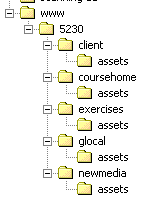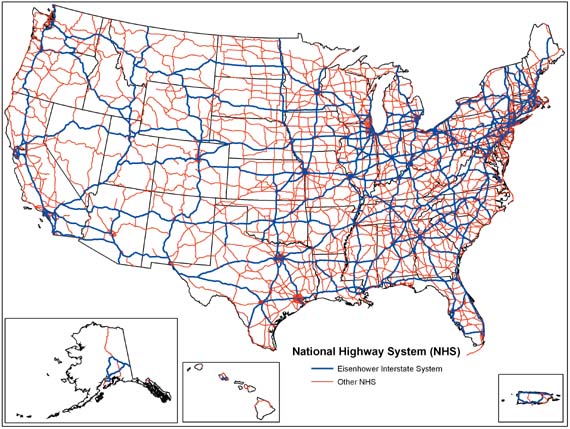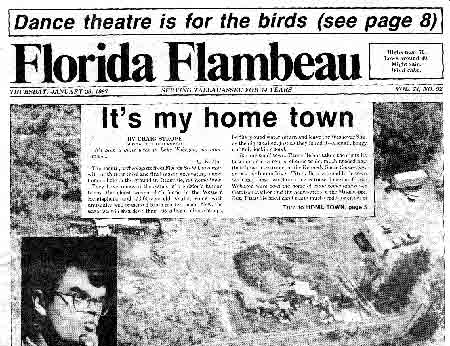Previous Blackboard Items

 This will be the home
page of COMP 5230 for spring 2003. Please return for updates as the semester
approaches This will be the home
page of COMP 5230 for spring 2003. Please return for updates as the semester
approaches
 Compare Jakob
Nielsen's "The End of Web Design" to David
Siegel's passage from his book Creating Killer Web Sites to
appreciate how Web design is a kind of conversation between the cultures
of engineering and design. Compare Jakob
Nielsen's "The End of Web Design" to David
Siegel's passage from his book Creating Killer Web Sites to
appreciate how Web design is a kind of conversation between the cultures
of engineering and design.
Now, let's do Journal Entry #1: Where would you locate yourself
in this conversation between the engineer and the designer? Where do your
sympathies lie? What does the "other side" need to understand
better? Where do you want to take this conversation?
 Introducing the first
project, the Personal Course Home Page. Introducing the first
project, the Personal Course Home Page.
 I much prefer to give
you tools rather than rules, but let's review the page Rules
to Set You Free and think of them as "enabling restraints" I much prefer to give
you tools rather than rules, but let's review the page Rules
to Set You Free and think of them as "enabling restraints"
 Our first exercise
will be the Imagetext. Here's a
sample Imagetext page. The exercise is fully described on the handout
"Imagetext Exercise using Invisible Layout Tables." Our first exercise
will be the Imagetext. Here's a
sample Imagetext page. The exercise is fully described on the handout
"Imagetext Exercise using Invisible Layout Tables."
 To post your Imagetext
exercise to the Web, you'll need information from my page on transferring
HTML files at UMD. To post your Imagetext
exercise to the Web, you'll need information from my page on transferring
HTML files at UMD.
 Remember last week
I asked you to find several personal home pages on the Web which you think
are notable for either good or bad design ideas, and to bring in the URLs
of those pages. Remember last week
I asked you to find several personal home pages on the Web which you think
are notable for either good or bad design ideas, and to bring in the URLs
of those pages.
This evening--or by the end of the week if we run short of time tonight--please
post the complete URLs (including "http://...) of the sample Personal
Home Page Designs you found to our
discussion board. Once you log in, open the discussion called "Personal
Home Page Design Examples." and post those URLs there.
After each URL in your posting, rate each site with a five-star system
(for example, ***** or **1/2) and write a short paragraph pointing out
design features that you thought we might emulate in our own Personal
Course Home Page Projects, or that we should remember as a negative example.
Be sure to include your name at the bottom.
 Readings Readings
Tonight, we'll be talking about Nielsen's Chapters 2 and the Gibson and
Heim readings in the Tredn collection (assigned last week)
 Next Week's Readings Next Week's Readings
Nielsen's Chapter 3 (page 98-160)
Sherry Turkle's "Who Am We" (Trend 236-250)
|
 Folder Management Folder Management
Make a set of folders on your Zip disk that look like those on the
right:
A Couple of Tips:
Make one new folder (right-click, choose New > Folder)
Copy the new folder and paste it again and again (right-click,
Paste), then click the name of each copied folder to change the
name
Make the "assets" folder once, copy it (right-click on
it, then choose "Copy"), then paste it into each of the
folders that need an "assets" folder
This is all part of the Rules
to Set Your Free Regime.
|
 |
 Turning in the
First Project Turning in the
First Project
By Sunday at 6 p.m., the Personal Course Home
Page project is due to be posted and "turned
in" in via the course discussion board. Next Wednesday, remember
to bring a print out (black and white is fine) of the page to turn in
physically.
 Three Amigos Three Amigos
Some of you are stressed out about producing or  posting the Imagetext exercise from last Wednesday. This exercise was
a crash course in Dreamweaver, the equivalent to being thrown into Lake
Superior and told to learn to swim. Luckily, you're not alone.
posting the Imagetext exercise from last Wednesday. This exercise was
a crash course in Dreamweaver, the equivalent to being thrown into Lake
Superior and told to learn to swim. Luckily, you're not alone.
First, you can (and should) communicate with me if you're unable to complete
one of these exercises. The whole point of making you responsible for
posting these exercises is to make both of us aware of what you
know and don't know. I'm here to help.
Second, you have your classmates. This evening we'll do our first "Three
Amigos" activity in class, in which you'll simply get together with
two classmates and share problems and solutions to particular challenges.
Tonight, we'll be troubleshooting the Imagetext exercise. If you three
amigos can't figure it out, wave me down.
In 10 minutes, everybody should be sorted out and have a better idea
of what you'll need to do next time.
 Banner Techniques
Exercises (Beginning and Intermediate) - Photoshop Banner Techniques
Exercises (Beginning and Intermediate) - Photoshop
For the Banner and Intermediate Banner Exercises, you'll need this raw
digital image. Right-click the image after it appears and choose "Save
Image As." Save it in www/5230/exercises/assets (that is, the assets
folder, inside your exercises folder, inside your "5230" folder,
which is inside your "www" folder).
 Readings and Discussion Readings and Discussion
Tonight, we'll be talking about Nielsen's Chapter 3 (Content Design) and
Ann Turkle's essay "Who Am We" from the Trend collection
 Introducing the
Glocalization Site Project (#2) Introducing the
Glocalization Site Project (#2)
With The Glocalization Site, you'll create a Web site that allows
a global audience to experience some aspect of Duluth, Lake Superior,
the Northshore or some similar locale. Because this global audience is
possible only through the Internet, assume that they will never physically
visit your locale. The only relationship your audience will ever have
with your place is the online experience that you create, and the things
you find to show and tell them. Luckily, you can "narrowcast"
to a very particular audience with specific tastes and interests. More...
  Three
Amigos II Three
Amigos II
We'll re-convene the Three Amigos (get into groups of three with your
neighbors) to ask and answer the question: What do you want to know
how to do in Dreamweaver and Photoshop?
 Readings and Discussion Readings and Discussion
This evening, we'll talk about Brenda Laurel's and Timothy Allen Jackson's
essays in the Trend collection
 Individual Conferences
Next Week--no class meeting Individual Conferences
Next Week--no class meeting
Next week's class meeting is cancelled so we can do individual conferences
in my office, Humanities 420. Please sign up for a time slot using the
discussion board by clicking the link there for either Monday
or Wednesday.
If you can't make any of the times, please e-mail me to make other arrangments.
Be sure to sign up only for times within the time spans listed on each
day.
 Introducing the
New Media Writing Project Introducing the
New Media Writing Project
This project will ask you to begin a new media project by working in an
old medium--writing. You'll write a three-to-five page essay or account
that describes your individual history with a public experience. A "public
experience" is something that a public experienced and remembers
together: a television series, a local event, the career of a musical
group, a forest fire, a news event, etc. The "public" may be
a local (a town or region), national or global. You will write an argument,
narrative or explanation about a topic you know and care about in a three-to-five
page "paper." Then you'll repurpose and "remediate"
that material to create a Web site that fulfills the same purposes except
in a digital environment. More...
 Image Maps Image Maps
We'll learn how to make image maps in Dreamweaver. You'll be using your
Imagetext page in this exercise.
 Turning in the
Glocalization Project next week Turning in the
Glocalization Project next week
Note that the Glocalization Project is
now due on Monday, March 10 rather than on
the 9th. You'll turn in this project by doing the following:
- Posting the Web site to the folder "www/5230/glocal" Monday,
3/10 at 6 p.m.
- By the same time, post a message to the Webx discussion "Glocalization
URLs" with your name and the complete URL (including "http://...")
of your site: for example: Craig Stroupe, http://www.d.umn.edu/~cstroupe/5230/glocal
- Place a link on your Personal Course Home Page to your Glocalization
Project
- On Wednesday, 3/12 in class, turn in
an "annotated" printout (black-and-white okay) of the entire
Glocalization site in class. By "annotated" I mean that you
should hand-write some brief comments on the printout, pointing to and
commenting on particular features that you want me to pay attention
to or understand. Include items that you are especially pleased with,
that you had trouble with, or that raise unanswered questions for you.
 New
Media Writing Essay due next Wednesday. New
Media Writing Essay due next Wednesday.
 Readings and Discussion
Tonight Readings and Discussion
Tonight
Tonight, we'll be talking about the Margaret Morse and Howard Rheingold
readings in the Trend collection.
 Readings and Discussion
Next Week Readings and Discussion
Next Week
For next Wednesday, Read Pierre Levy's "Collective Intelligence"
on pages 253-58 in Trend (only 5 pages!)
 Two Project Assignments Two Project Assignments
We'll also ask and answer questions about two of the last three projects
in the semester, the Analytical Essay I
and the Client Project.
 New Browser Windows
(Child Windows) in Javascript New Browser Windows
(Child Windows) in Javascript
Tonight, we'll be learning about the powers of Javascript by creating
a link to a "child window" from our Personal Course Home Pages.
Look on your home page to find some picture or verbal phrase that you
want to provide some extra information about without linking to an entirely
new page. See pages 420-421 in Towers Dreamweaver 4. There is,
however, a secret
that Towers doesn't tell you.
 Next Week Spring
Break, the Week After Cancelled for Conferences Next Week Spring
Break, the Week After Cancelled for Conferences
The week after Spring Break we'll cancel our classmeeting to hold individual
conferences on either Monday
(starting from 11-12:15) or Wednesday
(starting from 2:30-4:15, 6:00-7:45). In these 15-minute conferences,
we'll discuss your Glocalization Projects, and your plans for reconceiving
your New Media Writing essay into a Web-based hypertext. 
 Guest Speaker Next
Class Meeting (April 2) Guest Speaker Next
Class Meeting (April 2)
Steve Kineey from Minnesota Power (ALLETE) will be visiting class on Wednesday,
April 2 to talk informally about his experiences writing, editing and
supervising the production of the Allete
web site. Since I didn't want Steve to have to prepare a speech or
presentation, I assured him that you all would have lots of questions
to keep the ball bouncing! Here's a brief bio
of Steve.
 Journal Entry 2:
Believing, Doubting and Thinking (Pierre Levy) Journal Entry 2:
Believing, Doubting and Thinking (Pierre Levy)
For the Analytical Essay Project, you'll be using sources from the Trend
book that you may agree or disagree with (or feel disengaged from).
1. In his book Writing Without Teachers, Peter Elbow considers
the role of (dis)belief in the "intellectual enterprise,"
which I summarize on the page The
Believing and Doubting Games.
2. Let's try this our using our reading for this evening, Pierre Levy's
"Collective Intelligence" on page 253. Find an sentence/idea/passage
from Levy that you find yourself resisting or doubting. Then find another
sentence/idea/passage to which you feel yourself responding positively
or believing. In the Webx discussion "Journal
2: Levy (3/12)," write a short paragraph about each item (2
short paragraphs altogether) using Elbow's analysis of the believing
and doubting games:
- one paragraph in which you quote or paraphrase the passage, cite
the page number, and then think through your own resistence to this
idea from Levy. How does it help you "locate" yourself,
to suggest where you're coming from or where you're going (culturally,
politically, ideologically, etc.)? Why are you invested emotionally
or intellectually in doubting this idea?
- one paragraph in which you quote or paraphrase (and cite the page
number of) the passage you found yourself responding to or liking:
again, how does this situate you among the issues. Where does the
sense of emotional investment come from that you feel toward this
idea?
3. Finally, read over some of the postings by your classmates and respond
to one, comparing your response to his/hers and pointing out the connections
or contrasts. Be engaged but not aggressive, positive but not blandly
"nice."
 Ambiguity and Commitment Ambiguity and Commitment
Recognizing the situated and ambiguous nature of ideas doesn't necessarily
result in a wishy-washy relativism. The critic Fredric Jameson gives an
example of intellectual subtlety and passionate commitment in his distinction
of Dialectical Thinking & Moral
Positions.
 Forms Forms
This evening, we'll learn about creating forms in Dreamweaver. See the
in-class handout.
 Next Week and a
Week From Monday Next Week and a
Week From Monday
 Guest Speaker Tonight:
Steve Kinney Guest Speaker Tonight:
Steve Kinney
Steve Kinney from Minnesota Power (ALLETE) will be visiting class on Wednesday,
April 2 to talk informally about his experiences writing, editing and
supervising the production of the Allete
web site. Since I didn't want Steve to have to prepare a speech or
presentation, I assured him that you all would have lots of questions
to keep the ball bouncing! Here's a brief bio
of Steve.
 Writing Dialectical
Paragraphs Writing Dialectical
Paragraphs
In preparation for completing the Analytical Essay
I assignment, we'll work with some "Dialectical Paragraphs"
from previous student work.
Then I'll ask you to visit The Weather
Channel's Web site to begin putting together a similar dialectical
encounter between specific features of that site and the ideas of "the
body vs. virtuality," including Pierre Levy's ideas of "anthropological
space" presented in his essay "Collective Intelligence"
(Trend 253).
For instance, can you find specific details and elements of The Weather
Channel site that "call up" the virtual visitor's identity:
- on "earth," represented by our name and placing us
"within an ancestral line" (256)
- in "territorial space," expressed in an "address,
which serves to represent us within the territory of residents and taxpayers"
(256)
- in "commodity space," represented by our role or
status in the economy, and typically indicated by our profession (position
in the commodity space)" (257)
Send a message to the Webx discussion "The
Weather Channel and The Body (Journal #3, 4/2)," recording your
observation of some details from the site and commenting, dialectically,
on how these details call up our bodily identities in one of Levy's "anthropological"
spaces.
 Rob Wittig,
e-lit author and researcher, will speak at the Tweed Museum's Lecture
Gallery on Tuesday, April 15 at 10 a.m. Visit Wittig's
site to see examples of his work. His talk is entitled, "Creation
at the Crossroads of Literature, Design and New Media." Rob Wittig,
e-lit author and researcher, will speak at the Tweed Museum's Lecture
Gallery on Tuesday, April 15 at 10 a.m. Visit Wittig's
site to see examples of his work. His talk is entitled, "Creation
at the Crossroads of Literature, Design and New Media."
 Conference Sign
up - no class next week Conference Sign
up - no class next week
Sign up for a conference either on Wednesday,
April 16 or Thursday,
April 17 via the Webx Discussion.
 Adding a Search
Engine to Your Site Adding a Search
Engine to Your Site
We'll learn to put a search engine on your site (atomz.com).
From the Atomz home page choose, "Products" "Atomz search"
and then "trial account" and follow the directions from there.
 Home Town Blues
(New Media Writing Group Exercise) Home Town Blues
(New Media Writing Group Exercise)
Tonight, I'm handing you an article I wrote way-back-when, which was
published in Florida State University's student newspaper, The Flambeau.
I'd like to ask you to work in groups to help me reconceive of this linear
article (which is really like your Public Event/Personal History essays)
into a Web-based hypertext. This will give us some collective and collaborative
practice in what you're doing individually in your New
Media Writing Projects.
Read over the following steps completely before we begin the process
so you'll know what we're doing:
On Your Own:
1. Read my article as a print text.
2. Look for and mark the text for discrete chunks that may make separate
screens or "lexias"
With a group of three or four
3. As a group, choose one chunk to focus on
4. Open up the electronic version of
the article and copy the chunk of text you've chosen onto a blank HTML
page. (If you're viewing this page with Internet Explorer, you'll need
to right-click on this link to choose to open it with Word.)
5. Look for ways the text could be subdivided with white space, headings,
sidebars, etc.
6. How should the text be edited: shortened? supplemented? reorganized?
What considerations go into editing a text for the screen?
7. Do a Google search for some kind
of image to put with the text (maybe not the most obvious one, but something
that draws out and underlines some detail, some idea, even something between
then lines). Download the image and place it on the page with the text
8. Think about a title for the page. What words would you use to link
to this page from other pages in this hypertext? (Something clever? literal?
engaging? clear? suggestive? descriptive? intriguing?). Put this link
anchor label in the "Title" box at the top of the Dreamweaver
workspace.
9. Work with your group to put it all together and post it to somebody's
"exercises" folder with the name of everyone who worked on it
at the bottom.
10. Post the URL of your page to Hometown
Screens with the names of your group members in the first line of
the message so it will appear in the title
11. Once you've posted, we'll go around to each of the groups to look
at what you came up with and let you take us through through the page,
explaining what what you did and why you did it. Did your group have any
creative disagreements about the choices you faced?
4/23/03
 Introducing
the Analytical Essay II (Synthesis of a Debate) Introducing
the Analytical Essay II (Synthesis of a Debate)
 Client Project
Proposals, Workshop Next Week Client Project
Proposals, Workshop Next Week
This evening we'll distribute copies of our Client Project Proposals in
preparation for in-class workshops over
the next two weeks. We will do Projects 1-12 next week (4/30) and Projects
12-23 the week after (5/7). You'll find URLs to the projects in the Webx
discussion "Client
URLs" after 6 p.m. on Monday, 4/28.
| Project # and Name (W 4/30) |
Project # and Name (W 5/7) |
| 1. Joshua G |
13. Sam M. |
| 2. Tom S. |
14. Robin O. |
| 3. Travis J. |
15. Scott B. |
| 4. John S. |
16 |
| 5. Erik Y. |
17 |
| 6. Andy M. |
18 |
| 7. David R. |
19 |
| 8. Dane P. |
20 |
| 9. Gregory R. |
21 |
| 10. John K. |
22 |
| 11. Bob I. |
23 |
| 12. Lucas W. |
|
 Client Project
BETA version due Monday Client Project
BETA version due Monday
A BETA version of your Client Project Web site is due to be posted to
your "www" folder by next Monday, 4/28 at 6 p.m. Post your number
(from chart above), name and complete URL of the project to the Webx discussion
"Client
URLs."
 Preparing for Workshop
on Wednesday Preparing for Workshop
on Wednesday
Between 6 p.m. on Monday and 6 p.m. on Wednesday 4/30, all of you should
visit projects 1-12 and prepare responses according to the directions
on the workshopping page. Be ready to
discuss your reactions and suggestions to all 12 next week. We'll do 13-23
the following week. 
 Community Building
on Your Client's Site Community Building
on Your Client's Site
One of the few purposes common to all your Client Project sites will be
the goal of building community. This evening, I'll give you some notes
and we'll do some activities from Amy Jo Kim's book Community
Building on the Web.
A. Loyalty
- no longer based on location
- nor on "brand"
- relationships: with those in client's organization, with other customers
or members of audience
B. Ethos (Created sense of identity)
- backstory
- tag lines
- icons, symbols, colors, fonts
C. Channels: relationships in as many forms as possible
- Web site
- face to face
- phyiscal places
- e-mail list
- threaded discussion
- print (e.g., newsletter)
- t-shirts
 Tag Lines Tag Lines
Some examples:
- "Your Personal Trading Community" - eBay
- "Come for the games, stay for the party" - Mplayer
- "Real solutions for Women" - iVillage
- "A Great University by a Great Lake" - UMD
- "News for Nerds: Staff that Matters" - Slashdot
<back to Class Blackboard>
|

